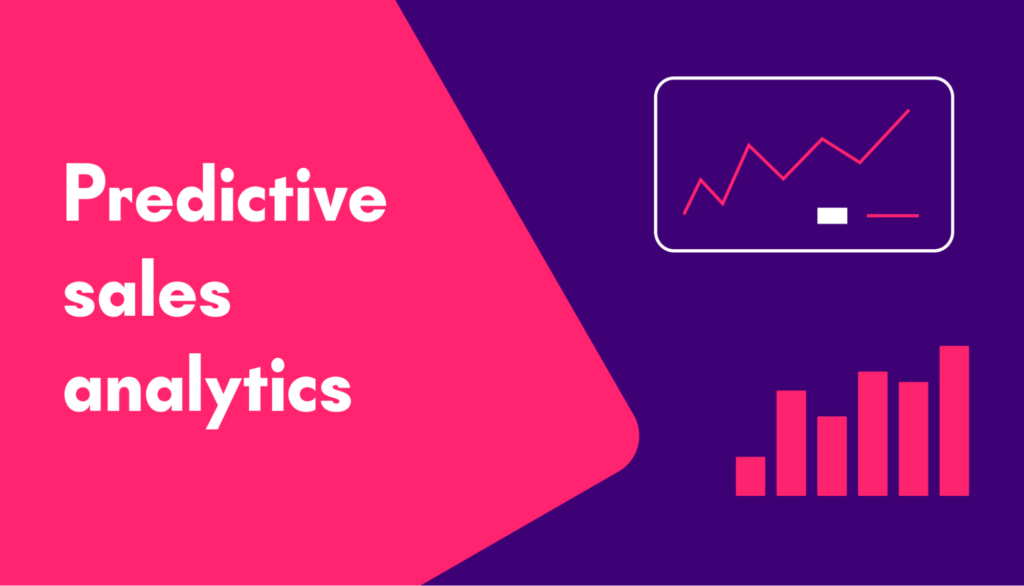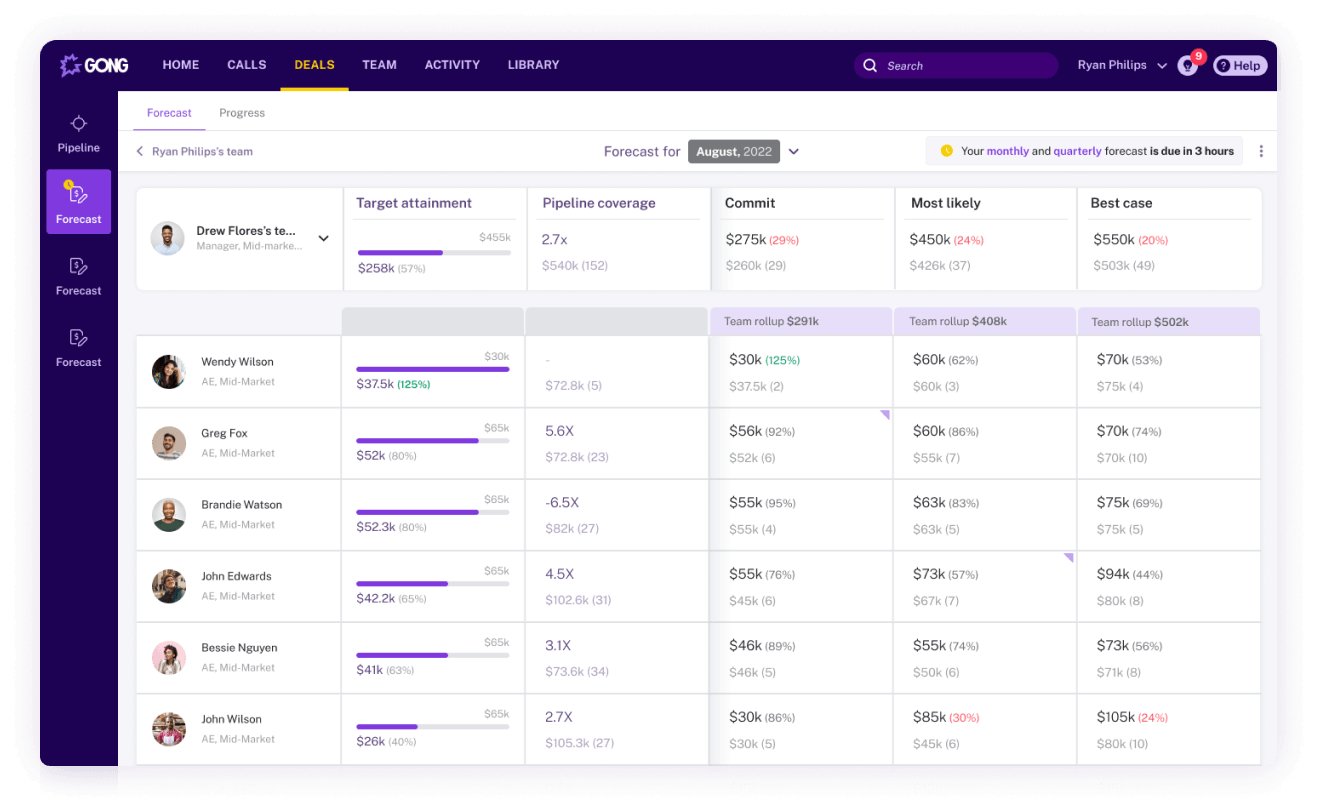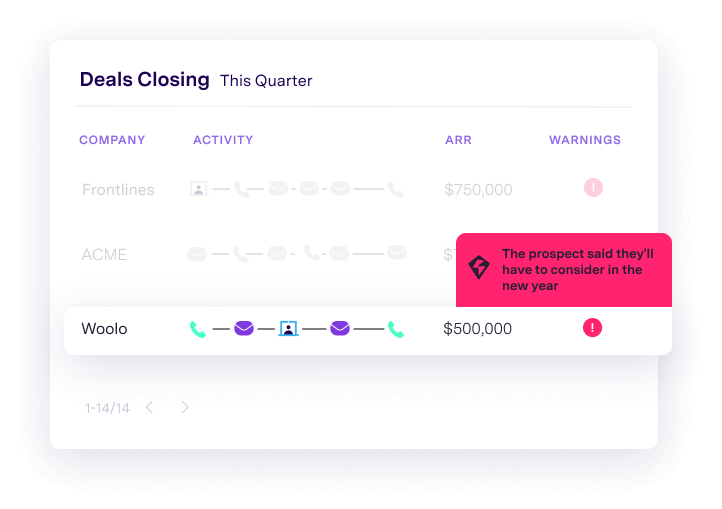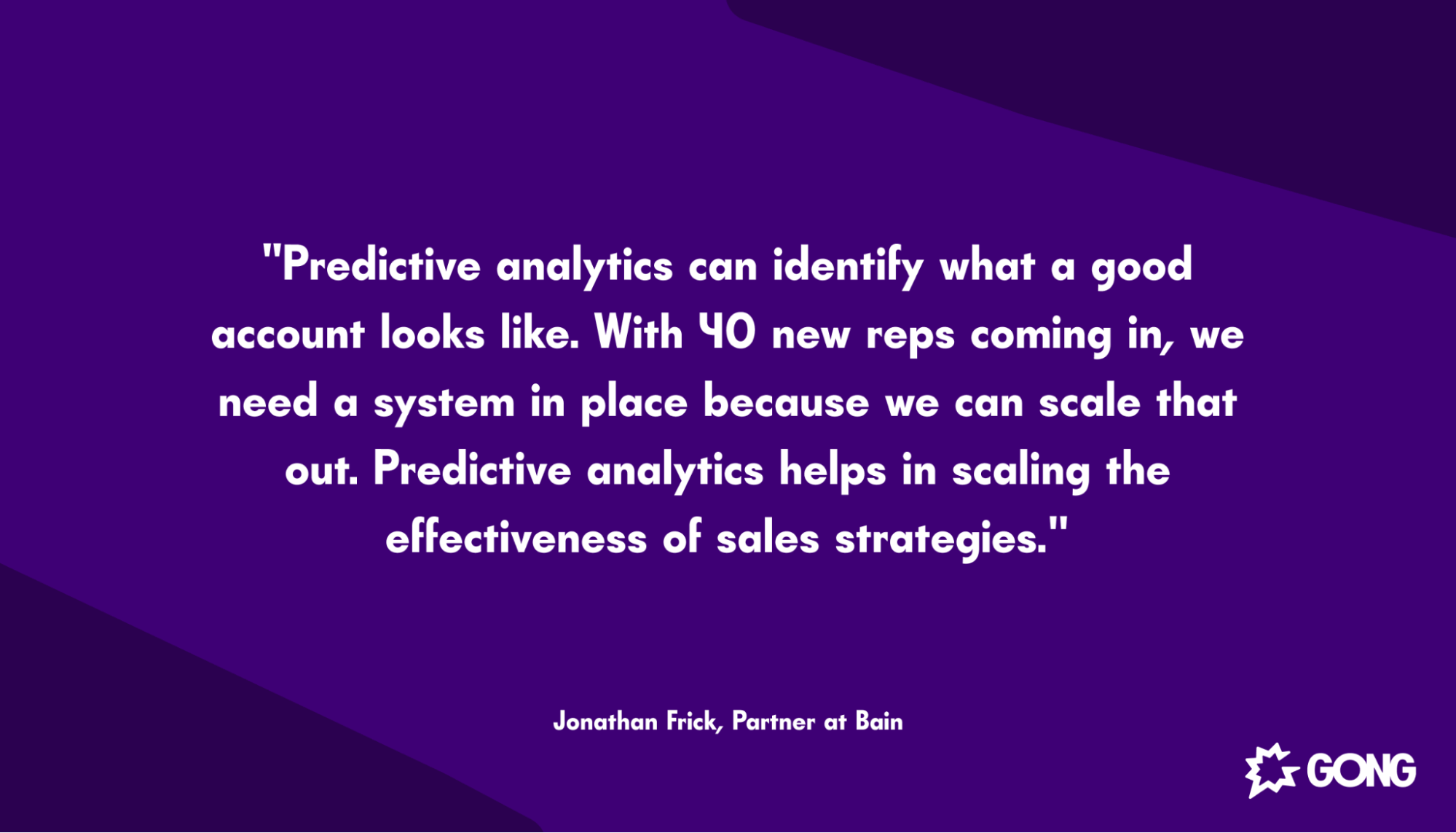Predictive sales analytics and the power of AI-driven forecasts

It’s hard to overstate the power of accurately forecasting how likely deals are to close or the revenue you’ll generate in a given timeframe.
Predictive sales analytics aren’t just numbers. They’re the foundation on which you and your company make great decisions about hiring, budgeting, marketing, sales strategies, and production schedules.
This guide explores the types of predictive sales analytics and how they can benefit your revenue teams.
What are predictive sales analytics?
Predictive sales analytics use data, statistical algorithms, and machine learning techniques to forecast future outcomes. These outcomes might include how much you’ll sell over a given period, what percentage of deals are likely to close, or which reps will hit their targets.
Until recently, most traditional sales analytics tools could only tell you what’s happening now (e.g., how much revenue your reps have committed). Today’s intelligent analytics solutions analyze real-time trends and apply predictive models to determine what’s most likely to occur in the future.
AI-powered sales solutions employ machine learning and predictive models to scan and sift through a wider range of data inputs. For example, Gong Forecast automatically captures and analyzes over 300 buying signals, including customer interactions, historical sales data, and information from integrated apps like Salesforce, Google Calendar, and Zoom.
In the image above, Gong Forecast automatically calculated and assigned each rep a “most likely” revenue figure and a “best-case” scenario.
Everyone in a sales organization can use predictive analytics to guide how they streamline workflows and improve performance:
- Sales leaders can use them to generate more accurate forecasts, allowing them to budget more effectively.
- Sales managers can better predict which reps will underperform this year, allowing them to provide personalized coaching.
- Sales reps can predict customer objections, allowing them to prepare better and overcome those challenges more often.
In short, predictive sales analytics are the new cornerstone of a top-performing revenue organization.
What are the four types of analytics?
There are four main types of analytics. Each provides targeted insights into the four stages of decision-making: what happened, why it happened, what could happen, and what to do next.
- Descriptive analytics analyze what already happened, relying on historical data to identify patterns and trends, summarize facts, and reveal insights that can influence future strategies.
- Diagnostic analytics explain why something happened. This method also uses historical data to identify the cause of events such as lost deals or sudden increases in churn.
- Predictive analytics estimate the probability of future events. This approach applies advanced models and statistical algorithms to various data sources and analyzes current trends to predict an event’s likelihood.
- Prescriptive analytics determine the best course of action. Using advanced statistical models, this approach works best when you need to analyze the likelihood of specific outcomes and get suggested next steps.
Traditional sales analytics tools can only execute the first two types of predictive analytics. But intelligent sales solutions like Gong can handle all four.
Specifically, Gong Forecast looks at your past customer interaction data to identify themes and trends. Then, it identifies similar deals in your current pipeline to see how they’ve turned out in the past. With those insights, sales leaders can spot the deals most likely to close and the ones most likely to go sideways.
If you use Gong in your sales organization, it will analyze historical data alongside insights from current deals’ sales calls to assign a predictive score for each deal in your pipeline. The higher the score, the more likely a deal is to close.
AI-driven sales solutions can provide unbiased, accurate customer insights, so you don’t have to rely on individuals’ recollections and assumptions. Gong automatically captures and analyzes every customer interaction so you can spot at-risk deals, enhance pipeline visibility, and improve forecast accuracy.
Have a look, for example, at this example from Wooloo, in which a prospect said the deal might close in the new year instead of the current quarter:
Knowing this improves forecast accuracy and allows you to coach and allocate resources more effectively.
How to use predictive sales analytics to drive revenue
Predictive sales analytics eliminate the guesswork. With data-driven quotas, more accurate targets, and more informed decision-making, sales teams are more confident and effective — whether they’re closing a deal or setting next quarter’s sales goals.
Here are three specific ways you can use predictive analytics to drive revenue in your organization:
Anticipate prospects’ behavior
When you can accurately predict buyer intent, you can prioritize and grow your pipeline effectively. You can divert effort and resources away from low-intent prospects and focus your reps’ energy on the prospects most likely to convert.
A predictive analytics tool enables this approach by leveraging conversation intelligence data. An AI model like Gong’s can pull from every single customer conversation to pinpoint what matters to prospects and surface objections like competitor pricing.
With these actionable insights, sales reps can adapt their strategies based on customer behaviors by highlighting relevant product features or addressing objections early in the process. According to data from Gong Labs, this can increase win rates by 35 percent.
Improve forecast accuracy
Forecasts underpin many parts of the sales process, from setting targets to allocating budgets and making hiring decisions. Accurate predictions are essential, but many sales teams need help creating them.
According to a global Harvard Business Review Analytic Services survey, less than one-quarter of executives think their forecasting methods accurately predict sales, accelerate successful initiatives effectively, or identify top performers.
Underforecasting and overforecasting are both dangerous.
When you overforecast, you may eventually need to cut costs and reduce your workforce. When you underforecast, you miss opportunities to accelerate a successful initiative and create onboarding problems for new customers.
The good news is inaccurate forecasts are a data problem that predictive sales analytics can address.
An AI-powered solution like Gong collects and analyzes data from hundreds of sources to find patterns and trends that traditional sales forecasting solutions would miss. That allows you to predict pipeline outcomes with up to 90 percent accuracy.
With more accurate sales forecasts, revenue leaders can:
- Allocate resources effectively, whether that’s investing in a new market or hiring SDRs
- Create realistic and achievable targets for reps and update them in real time
- Double down on successful sales initiatives to optimize revenue
Most importantly, predictive analytics provides more accurate forecasts that you can confidently present to stakeholders and executives.
Accelerate forecast execution
Opinion-based forecasts are time-consuming to create and analyze. First, you have to corral data from your CRM and other platforms, often into static spreadsheets. Then you have to chase reps for their opinions. Finally, you must review each deal individually to predict whether it’s likely to close.
The right predictive sales analytics platform can automate all of this. There’s no need to chase sales reps when predictive models automatically run forecasts based on the data they collect from your CRM and other integrated sales tools.
Data-driven decisions happen faster as a result. A predictive forecasting model allows sales managers to invest more heavily in a profitable new market now rather than waiting to make decisions at the end of the quarter, leaving revenue on the table.
Refine buyer personas
Predictive analytics can identify what a good account looks like. With 40 new reps coming in, we need a system in place that we can scale out. Predictive analytics helps in scaling the effectiveness of sales strategies.
Jonathan Frick – Partner, Bain
Reveal Podcast: 10 takeways that will transform the way you sell
Most marketing teams use CRM information or sales reps’ feedback to create buyer personas. CRMs are great for storing contact information and important persona details like pain points, motivations, and buying patterns, but they can quickly become outdated.
Sales reps need up-to-date, detailed, customer profile information to personalize the buying experience.
Solve this using a predictive sales analytics platform that has conversational intelligence to add genuine color to your personas. Rather than basing personas on feedback from your sales reps, you can fine-tune them using real customer insights and interaction data.
Predict future sales trends
Even the most battle-worn veteran can’t spot everything in their sales pipeline — or the market. That can mean an untapped market goes unnoticed, or a potential upsell is overlooked.
Predictive sales analytics helps leaders stay ahead of their pipeline, flagging trends and insights they can act on immediately.
For example, given historical trends and real-time conversion intelligence, predictive sales analytics can identify upselling and cross-selling opportunities by predicting which products or services a customer will need in the future.
Reps can take the initiative and sell these features up front, increasing customer value and boosting deal size.
Real-world examples of predictive sales analytics with Gong
We know that forecasting is as challenging as it is essential. Our research shows that while 63 percent of leaders believe forecasting is critical to success, only 27 percent think their forecast methods are accurate.
You spend hours collecting data, chasing individual reps to submit their numbers, and prepping for meetings. You spend those meetings painstakingly combing through those deals one by one. Even then, you still can’t be sure your forecast is more than 50 percent accurate.
Rather than relying on second-hand data and assumptions, Gong Forecast fuels predictive models with real-time customer interaction data to deliver accurate, actionable results.
Here are two companies already succeeding with Gong:
1. Piano increases forecast accuracy by 90%
Piano is a leading data analytics and customer engagement platform that helps major brands like Air France and LinkedIn understand and influence customer behavior.
The company needed help with its revenue forecasts. Before Gong, pipeline data was spread across multiple systems, such as Salesforce, Google Drive, and Slack.
Locking in predictable revenue: Gong takes Piano’s forecast accuracy to 90%
Gong Forecast solved this by centralizing all their data in one platform. Now, everyone operates from a single screen, allowing weekly forecast calls to happen with zero prep.
AI-driven insights like Deal Likelihood Scores and Deal Warnings help the teams prioritize their sales efforts to close as many deals as possible.
Quarterly revenue projections are much more accurate too. Where their numbers could vary by millions in the past, Piano can now forecast with 90 percent accuracy thanks to Gong’s predictive analytics.
“The progress we’ve seen from what the CRM, sales managers, and even the CRO used to tell us was going to land is astronomical,” says Peter Lastowski, VP of Revenue Operations at Piano. “We’ve closed the gap by millions. With Gong, our end-of-quarter forecasts are solid.”
It isn’t just revenue teams that benefit from using Gong. Piano’s marketing department uses it to generate insights and identify pipeline gaps for specific segments.
2. Crayon spends 66% less time on forecasting calls
Crayon is a leader in competitive intelligence software. Brands like ZoomInfo and Dropbox rely on Crayon to track competitive intel and analyze information across their entire organization.
Previously, Crayon used several platforms to track deal information and collate everything in a Google Sheet. Now that they don’t have to spend hours chasing down individual reps for sales numbers, their forecasting process is more efficient and effective.
How Gong Forecast helps Crayon create accurate and reliable forecasting
Gong’s forecasting capabilities cut Crayon’s forecasting time by two-thirds. Where calls used to take an hour, the sales team can now complete them in 20 minutes — and they’re more accurate.
Calls are also more transparent because everyone works from the same data and can see the full historical forecasting record.
“I have throughout my career said that there are two really dangerous things that I hear from salespeople or sales managers, and that is I think or I feel. Gong gives us the ability to move out of that very dangerous realm of emotion and into the realm of knowledge.”
Gong’s sales insights also power other departments, particularly product design and development. Gong brings customer feedback into the Product Board, which is pushed into Salesforce and feeds directly into Crayon’s product roadmap.
The future of forecasting is predictive sales analytics
A predictive sales analytics solution brings speed, precision, and automation to your sales cycle. That means better forecasting, stronger sales performance, more closed-won deals, and sharper buyer personas.
Centralizing your data in Gong’s Revenue AI Platform delivers even better results. While CRMs track basic deal stages and low-level customer interactions (and rely on reps for manual data entry), Gong automatically captures every customer interaction. The platform’s predictive models draw on more than 300 data points, so you can predict revenue more accurately than ever.
Book a demo to find out more.
For more forecasting insights check out these resources:
Guide: Successful sales forecasting in five steps



